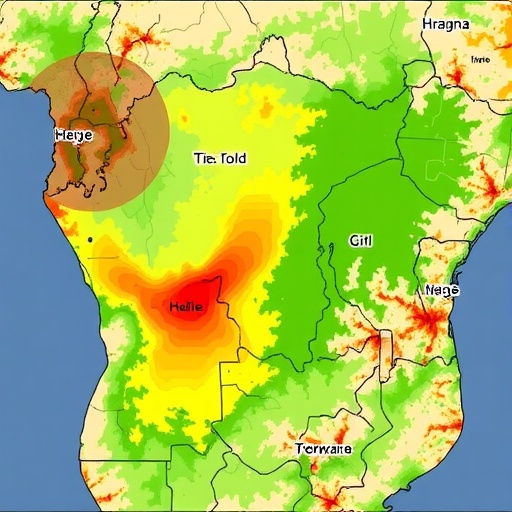In recent years, the shared understanding of climate change’s impact on biodiversity and agriculture has intensified among scholars and environmentalists alike. In the realm of agri-ecosystems, understanding how species adapt and thrive in changing climates becomes paramount. The research conducted by Washaya, Manyangadze, and Washaya provides a critical insight into this field by modeling the current and future spatial distribution of suitable areas for the species V. polyanthes in Zimbabwe. Using advanced statistical methods, the authors shed light on the nuanced interactions between ecological factors and the distribution outcomes forecasted across various climatic scenarios.
The species V. polyanthes, known for its adaptability and resilience, occupies a unique niche, especially in the diverse landscapes of Zimbabwe. However, as climate patterns shift, it becomes increasingly essential to discern where this species might thrive in the coming years. The driving forces behind the research involve a blend of ecological knowledge, advanced computational modeling, and a keen awareness of climate dynamics. The authors employed MaxEnt, a maximum entropy modeling approach, to predict suitable habitat distribution based on environmental variables and existing biological data.
The results generated from the models indicate notable changes in the habitat suitability for V. polyanthes. As temperatures rise and precipitation patterns evolve, certain areas within Zimbabwe are projected to become more favorable for this species, while others may experience a decline in suitability. This aspect of the findings holds significant implications not just for conservation strategies, but also for agricultural planning and food security initiatives in the region.
Critically, the research emphasizes the importance of understanding local climate variables, which can be amplified through a holistic consideration of socio-economic conditions. By using climate data projected for the years to come, the study investigates possible shifts in agricultural viability, which are crucial for farmers and policymakers. By integrating climate projections with agricultural practices, stakeholders can better prepare for the altered landscape of crop success and biodiversity.
One of the primary advantages of the MaxEnt model highlighted in the study is its ability to leverage presence-only data, common in ecological studies, to create strong predictive maps that inform conservation efforts. This modeling approach efficiently identifies which environmental conditions correlate with current species distributions, allowing researchers to extrapolate future distributions under various climate change scenarios. As a result, stakeholders can utilize these insights to harness adaptive strategies that promote resilience against climate fluctuations.
Moreover, the findings add a strategic dimension to ongoing debates surrounding agriculture in the context of climate adaptation. As countries like Zimbabwe tackle the dual challenges of food security and biodiversity loss, research such as this can pave the way for informed decision-making that balances both conservation efforts and agricultural productivity. It opens discussions on resource allocation, adaptation techniques, and innovative farming practices that could be adopted in the face of environmental change.
Notably, the research does not just stop at the individual species level; it also speaks volumes about ecosystem health and interdependence. As habitats change, so too do the interactions among various species, which can lead to cascading effects on the ecosystem. The authors invite agriculturalists, ecologists, and policymakers to consider the broader implications of their work, particularly regarding the interconnectedness of wildlife and agricultural practices.
As with any predictive modeling, uncertainties remain. The authors delve into the limitations of their study, discussing factors like data availability, the unpredictability of future climate conditions, and the challenges in obtaining accurate species occurrence data. Yet, they argue these limitations could spark further research opportunities that refine modeling techniques and improve data quality in the ecological sciences.
Promoting resilience in agricultural systems isn’t solely about protecting individual species like V. polyanthes; it involves enhancing the overall robustness of food systems to withstand environmental stresses. In turn, such resilience is vital for the livelihoods of those who depend on agricultural productivity, particularly in developing nations facing the brunt of climate change.
Furthermore, the researchers encourage multi-disciplinary collaboration when addressing these complex challenges. Engaging with local communities, agricultural engineers, and conservationists is essential in responding to the implications of their findings effectively. This community-focused approach can lead to innovative solutions that leverage local knowledge and practices aimed at transforming agricultural resilience.
Ultimately, the work by Washaya, Manyangadze, and Washaya serves as a clarion call to action for academic circles and beyond, urging a proactive stance on agricultural practices amid changing climatic conditions. It challenges the scientific community to continue innovating in modeling practices while simultaneously translating research findings into actionable strategies that better equip local communities to face future challenges.
As we advance further into the 21st century, understanding the future of species like V. polyanthes tells us much about how we can prepare, adapt, and thrive amid the uncertainties that lie ahead in our environmental landscapes. Future studies must build on these foundations to develop comprehensive, actionable frameworks that promote sustainability and biodiversity conservation at both local and global levels.
Subject of Research: Spatial distribution of suitable areas for V. polyanthes in Zimbabwe
Article Title: Modelling the current and future spatial distribution of suitable areas for V. polyanthes using maxent in Zimbabwe.
Article References:
Washaya, D.D., Manyangadze, T. & Washaya, S. Modelling the current and future spatial distribution of suitable areas for V. polyanthes using maxent in Zimbabwe.
Discov Agric 3, 193 (2025). https://doi.org/10.1007/s44279-025-00331-3
Image Credits: AI Generated
DOI:
Keywords: V. polyanthes, habitat suitability, climate change, MaxEnt, Zimbabwe, biodiversity, agriculture, ecological modeling, conservation, food security.
Tags: advanced statistical methods in ecological researchagri-ecosystems adaptation strategiesbiodiversity conservation in changing climatesclimate change impact on biodiversityecological factors influencing species distributionenvironmental variables affecting plant habitatsfuture climate scenarios and species resiliencehabitat modeling for V. polyanthesMaxEnt modeling for habitat suitabilityspatial distribution of plant speciesV. polyanthes habitat potential assessmentZimbabwean flora and climate dynamics





